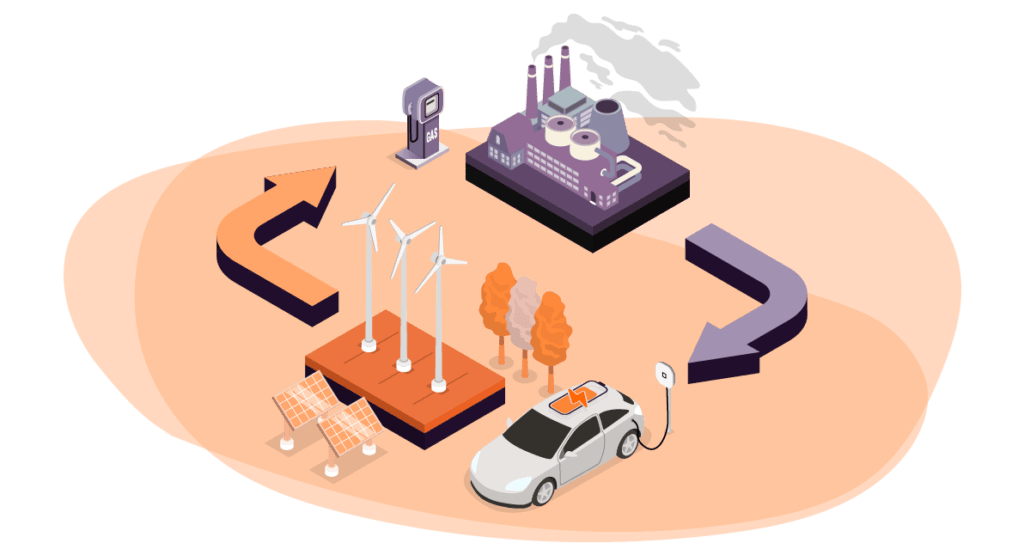Contact Info
2600 Technology Drive, Suite 100
Plano, Texas, 75074
United States
2600 Technology Drive, Suite 100
Plano, Texas, 75074
United States

Last Updated: June 1st, 2023 | Sustainable Business
In May 2023, researchers predicted a 66% chance that the world will pass the 1.5°C global warming before 2027. This news can kickstart action for reducing carbon emissions and push investment in environmentally friendly technology. Noodoe is dedicated to our electrification of transportation and empowering businesses to achieve their sustainability goals. That includes staying updated about new trends — for example, carbon credits. In this blog post, we will explore what carbon credits are, the generation process, how they relate to EV charging, and why they are important.
Carbon credits, also known as carbon permits or allowances, are not physical objects like certificates or credit cards. Instead, they are an intangible mechanism used to reduce carbon emissions. These credits represent greenhouse gas emissions reduced, avoided, or removed from the atmosphere. One carbon credit is equivalent to one metric ton (2205 pounds) of carbon dioxide (CO₂), or the equivalent in other gases such as methane (CH₄) or nitrous oxide (N₂O).
These credits allow the owner to generate emissions under a specified cap. If emissions exceed this cap, they must purchase additional credits from the market. The transferable nature of carbon credits offers businesses the opportunity to participate in the market.
There are two methods for credit generation: new clean developments or upgrading existing technology to pollute less. Both processes involve several steps.
First, establish a baseline for carbon emissions. This represents the greenhouse gas emissions that would have been produced without the sustainable activity. For example, the baseline for a wind farm would be the amount of greenhouse gas emissions that would have been produced if using coal instead.
Next, the actual emissions from the sustainable activity are measured and verified by an independent third party. The difference between the baseline and the actual emissions represents the amount that has been reduced or avoided. That difference is converted into carbon credits.
Finally, the carbon credits are tracked on a registry. This keeps a record of its ownership and transaction history. Businesses can sell credits in special markets or use them to offset emissions from other activities, such as air travel or industrial processes.
The use of carbon credits is a crucial mechanism in the efforts to combat carbon emissions. Understanding and caring about carbon credits can help individuals and organizations reduce their carbon footprint and promote sustainability. Utilizing EV chargers to generate carbon credits and contribute to the fight against climate change, there is a new opportunity to take significant steps toward a greener future.
| Cookie | Duration | Description |
|---|---|---|
| cookielawinfo-checkbox-analytics | 11 months | This cookie is set by GDPR Cookie Consent plugin. The cookie is used to store the user consent for the cookies in the category "Analytics". |
| cookielawinfo-checkbox-functional | 11 months | The cookie is set by GDPR cookie consent to record the user consent for the cookies in the category "Functional". |
| cookielawinfo-checkbox-necessary | 11 months | This cookie is set by GDPR Cookie Consent plugin. The cookies is used to store the user consent for the cookies in the category "Necessary". |
| cookielawinfo-checkbox-others | 11 months | This cookie is set by GDPR Cookie Consent plugin. The cookie is used to store the user consent for the cookies in the category "Other. |
| cookielawinfo-checkbox-performance | 11 months | This cookie is set by GDPR Cookie Consent plugin. The cookie is used to store the user consent for the cookies in the category "Performance". |
| viewed_cookie_policy | 11 months | The cookie is set by the GDPR Cookie Consent plugin and is used to store whether or not user has consented to the use of cookies. It does not store any personal data. |
